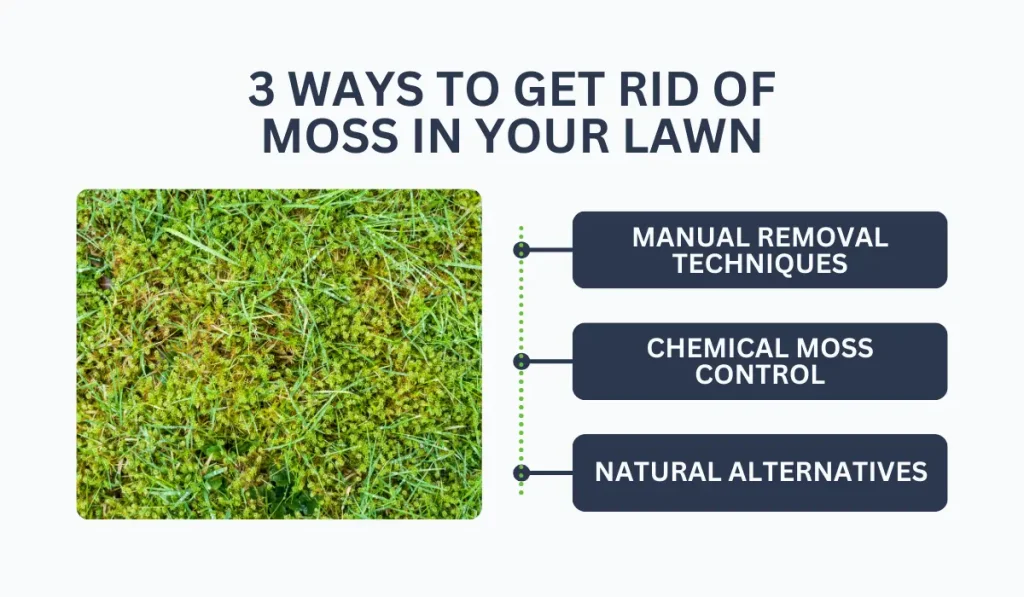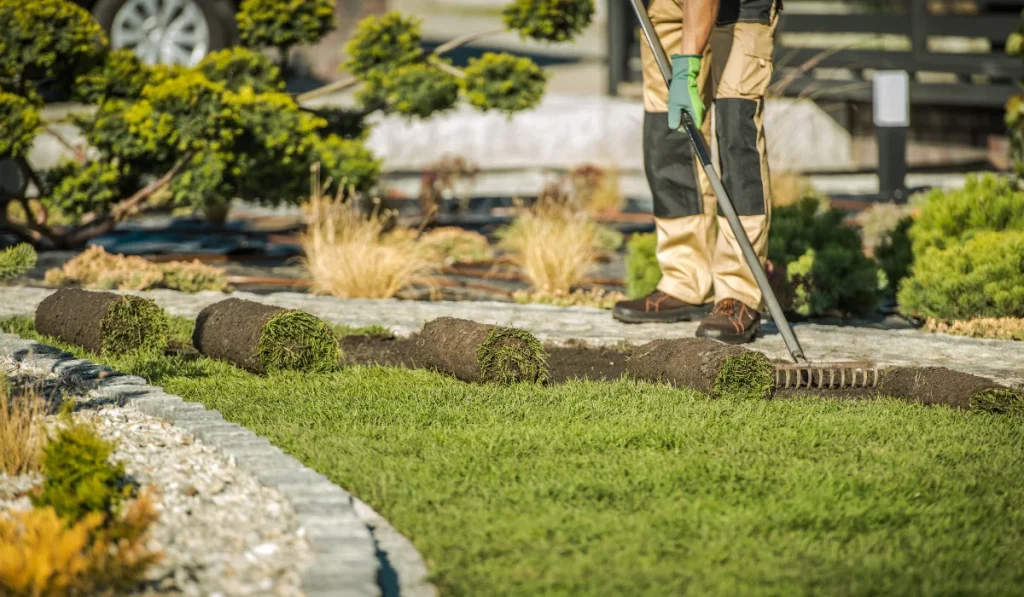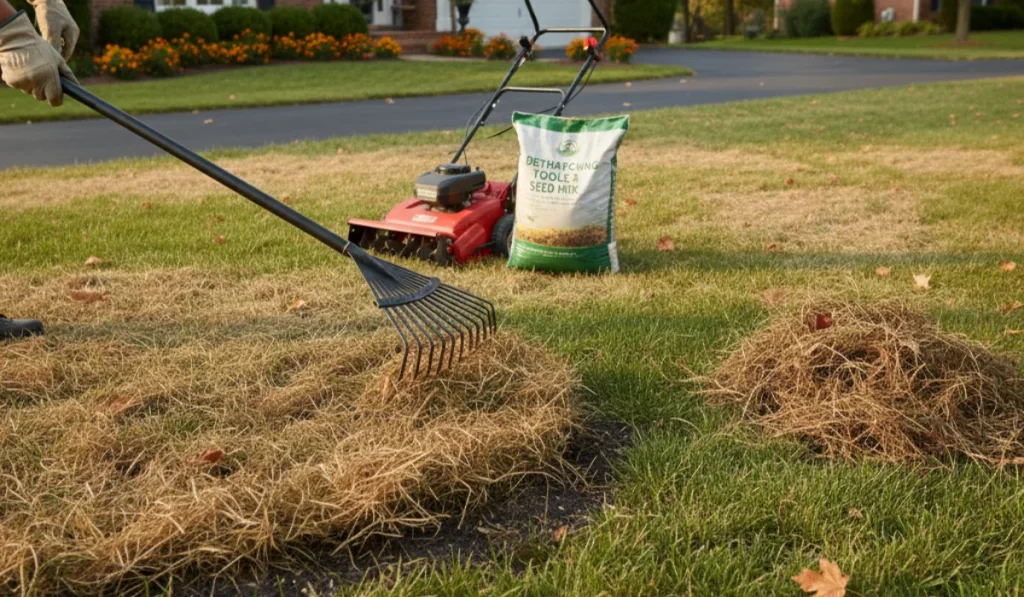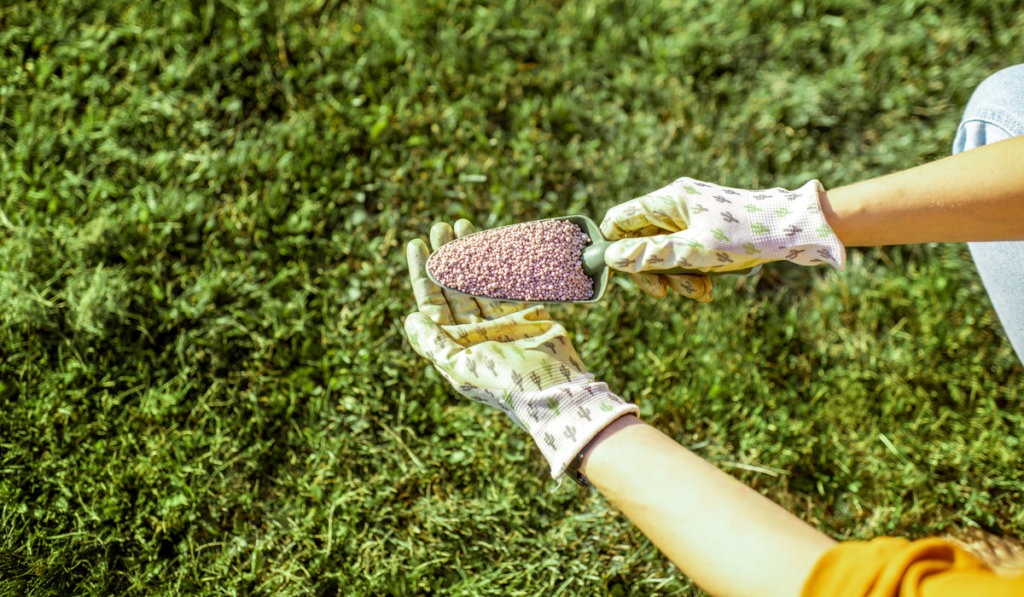Having a lush, green lawn is a point of pride for many homeowners. If you’ve noticed patches of moss taking over your lawn, it might be due to factors like poor drainage, compacted soil, or too much shade.
Using the right combination of techniques can help you tackle this lawn problem head-on. There are several ways to address this issue, from adjusting your soil pH to using moss control products.
Wouldn’t it be great to know which methods work best without harming your grass? Keep reading to discover the most effective strategies for removing moss and restoring your lawn to its lush glory.
Key Takeaways
- Manual moss removal can be accomplished using tools like rakes and dethatchers or simply pulling out small patches by hand.
- For an eco-friendly approach, use natural alternatives like baking soda or dish soap solutions to alter soil conditions and hinder moss growth.
- Preventing moss recurrence involves improving lawn drainage, increasing sunlight exposure, and promoting healthy grass growth through proper mowing, fertilization, and overseeding.
3 Ways to Get Rid of Moss in Your Lawn

Several effective methods can be used to tackle moss growth in lawns. To help you keep your lawn green and free from moss problems, ensure you understand these techniques.
1. Manual Removal Techniques
Manual removal is a hands-on approach to tackling existing moss in your lawn. This method requires physically removing patches of lawn moss using tools or even by hand.
To get started:
- Rake: Use a spring-tine rake to pull up the moss gently. This helps loosen it from the soil and makes it easier to remove.
- Dethatching Tools: Specialized dethatching tools or lawn scarifiers can effectively remove moss by cutting through the moss layer and bringing it to the surface.
- Hand Pulling: You can simply pull small patches of moss out by hand. Ensure you remove the roots to prevent regrowth.
2. Chemical Moss Control
Chemical moss control involves commercial weed killers designed to kill moss without harming the grass. These products prevent moss spores from germinating or targeting existing moss.
Popular products include:
| Products | Description | Application |
| Moss Out | A widely-used moss killer that targets moss while being safe for grass. | Follow the package instructions for application. |
| Iron-Based Products | Moss killers contain iron sulfate that turns moss black, making it easier to take out. | Apply during cool, damp conditions. |
| Herbicides | Specific herbicides formulated for moss control in lawns. | Ensure proper dosage to avoid lawn damage. |
3. Natural Alternatives
Organic and natural methods of moss control are eco-friendly and safe for pets and children. These methods focus on altering the soil conditions that allow moss to thrive.
DIY techniques to achieve moss-free lawns include:
- Baking Soda: Mix baking soda with water (2-3 tablespoons per quart) and spot-spray it on small moss patches. The alkaline nature helps to kill moss in the acidic soil.
- Dish Soap Solution: Combine one tablespoon of gentle dish soap with a gallon of water and spray on the moss. This breaks down the moss’s structure.
How to Restore Your Lawn Post-Moss Removal
After removing moss from the lawn, restoring and maintaining a healthy turfgrass with lawn care is crucial.
Seeding and Overseeding
Restoring your lawn often starts with seeding or overseeding, especially if moss has left patchy areas. To effectively restore the lawn through seeding or overseeding, follow these steps:
| Steps | Details |
| Choose the Right Grass Seed | Opt for shade-tolerant grasses to ensure better growth in shaded areas. |
| Preparation | Lightly rake the affected areas to remove debris and loosen the soil. This helps the seeds make better contact. |
| Seeding Rate | Spread the grass seed evenly. For overseeding, consider the recommended seeding rate on the package. |
| Watering | Gently water the seeded area. Daily, use about a gallon of water per square foot until the new grass is established. |
| Fertilizer | Apply a balanced organic fertilizer to provide essential nutrients for healthy grass growth. |
Lawn Maintenance Tips
Maintaining a healthy lawn post-moss removal requires ongoing care and attention. Regular maintenance ensures the grass remains lush and reduces the risk of moss returning.
To keep moss at bay, incorporate these essential lawn maintenance tips:
- Mowing: Keep the grass at a moderate height. Use a sharp mower blade for clean cuts.
- Watering: Water the lawn deeply and less frequently. Aim for about 1 inch of water per week.
- Aeration: Aerate the lawn during the cool season (i.e., early spring or early fall) using a tine or plug aerator. This helps improve soil aeration and root growth.
- Top Dressing: Apply a thin layer of topsoil or compost to add nutrients and improve soil structure.
- Fertilizer: Use a slow-release fertilizer in the growing seasons to maintain nutrient levels.
- Weed Control: Regularly remove weeds by hand or use a suitable weed control product.
- Iron Sulfate: Consider applying iron sulfate to prevent moss regrowth and enhance grass color. Apply according to product instructions using a sprayer.
How to Prevent Moss Growth in the Future
Eliminating moss is only part of the battle; ensuring it doesn’t come back involves various strategies.
Improve Drainage
Drainage issues often contribute to moss growth. When water pools on the lawn due to poor drainage or compaction, moss thrives, along with various lawn diseases.
Addressing drainage problems involves several steps, including:
- Aeration: Use a lawn aerator to create holes for better water movement.
- Dethatching or Scarifying: Remove the thatch layer to enhance soil contact.
- Lime Application (if needed): A soil test will reveal if your soil is too acidic and requires lime application to adjust the pH level.
Increase Sunlight Exposure
Moss grows well in shady, damp, or wet areas. So, increasing sunlight exposure to these regions can help prevent moss from returning.
Here’s how to increase the ground cover exposed to sunlight:
| What to Do | Details |
| Trim or Thin Trees and Shrubs | Allow more sunlight to reach the ground. |
| Garden Layout Planning | Avoid creating overly shady areas. |
| Monitor Mulch Levels | Prevent mulch from creating damp conditions. |
Promote Healthy Grass Growth
Healthy grass is excellent at outcompeting moss. By promoting robust turfgrass growth, you can create an environment less suitable for moss.
Steps to promote healthy grass growth include:
- Mow High: Keep grass at about 3 inches.
- Regular Fertilization: Follow soil test results for nutrient application.
- Overseed Bare Patches: Fill in thin areas to prevent moss establishment.
- Minimize Foot Traffic: Avoid excessive trampling of the lawn.



